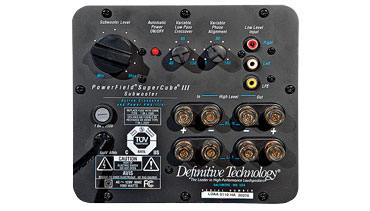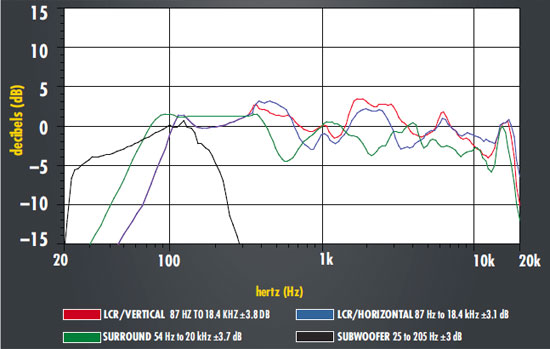Test Report: Definitive Technology Mythos XTR-50 Speakers Page 4


Test Bench
Frequency response (at 2 meters)
- LCR vertical 87 Hz to 18.4 kHz ±3.8 dB
- LCR horizontal 87 Hz to 18.4 kHz ±3.1 dB
- surround 54 Hz to 20 kHz ±3.7 dB
- subwoofer 25 to 205 Hz ±3 dB
Sensitivity (SPL at 1 meter with 2.8 volts of pink-noise input)
- LCR 89 dB
- surround 88 dB
Impedance (minimum/nominal)
- LCR 3.7/5 ohms
- surround 3.2/6 ohms
Bass limits (lowest frequency and maximum SPL with limit of 10% distortion at 2 meters)
- LCR 100 Hz at 70 dB
- surround 63 Hz at 81 dB
- subwoofer: 25 Hz at 82 dB SPL
- 98 dB average SPL from 25 to 63 Hz
- 101 dB maximum SPL at 63 Hz
- bandwidth uniformity 84%
Measurements of the Mythos XTR-50 were taken with the speaker mounted to a large piece of plywood, simulating a wall. The graph shows the measurements with the speaker mounted both horizontally and vertically. Both measurements are weighted to reflect the way sounds arrive at a listener's ears. In vertical mode, I used the weighting we normally use for a left or right front speaker; in horizontal mode, I used the weighting we normally use for a center speaker. I also measured the XTR-50 mounted vertically on its included stand, atop a 6-foot testing stand. The Mythos Gem was measured vertically mounted to the same ersatz wall I used for the XTR-50. All of these measurements were taken with the grilles in place, because it's unlikely anyone would use these speakers without the grilles. Measurements were made at 2 meters to ensure that the effects of cabinet diffraction, front panel reflections, and wall reflections were included. These tests gave quasi-anechoic results down to about 300 Hz. Response of woofers and radiators was close-miked, summed, and spliced to the quasi-anechoic response. The subwoofer's active driver and passive radiators were close-miked and summed.
The differences in the XTR-50 measurements are caused by differences between the speaker's horizontal and vertical dispersion patterns as well as by the different weighting formulas I used. (Our weighting emphasizes the response at 30° off-axis for left/right speakers, 0° for center speakers, and 60° for surround speakers.) The good news is that the speaker's slim design reduces the effect of wall reflections. Most wall-mounted speakers show a big dip somewhere between 500 and 800 Hz, and a big peak somewhere between 700 and 1,000 Hz. With the XTR-50, there's a broad and mild dip centered at 1.2 kHz and a broad and mild peak between 1.7 and 3.5 kHz. It all adds up to a pretty flat frequency response, especially for such a radical design. (The speaker measures even better, at ±3.4 dB, when measured vertically on a stand.)
To no surprise, off-axis response is better when the speaker is mounted vertically than when it is mounted horizontally-horizontally, a big dip of about -15 dB appears between 1 and 2 kHz at 45° and 60° off-axis, with a dip of about -8 dB appearing between 4 and 15 kHz. Vertically, the off-axis anomalies are limited to a narrow dip of about -7 dB at 4 kHz at 45° and 60° off-axis, plus a sharp, narrow dip of about -15 dB at 11 kHz. Overall, off-axis response is average.
The Gem measures surprisingly well for a multidirectional surround speaker. It's actually smoother off-axis; the peak in the response around 1 kHz flattens out at 45° and 60°, although the treble response is heavily rolled off at those angles.
However, the bass limits of the XTR-50 are rather severe. At 80 Hz, distortion was always above 10%, and at 100 Hz, I was able to get only 70 dB out of it at 10% THD. The Gem fared much better, delivering 81 dB at 63 Hz.
The impedance curves of the XTR-50 and the Gem run a little low, but given their good sensitivity, I doubt any halfway decent receiver would have a problem driving them. The XTR-50's minimum impedance is 3.7 ohms at 580 Hz and the Gem's is 3.2 ohms. However, the maximum phase shift of the impedance is only 25° for the XTR-50 and 30° for the Gem; the speakers' mostly resistive loads will make them easier on an amp. Also helping make the speakers easier to drive is their fairly high sensitivity. The XTR-50 delivers 89 dB at 1 watt/1 meter when freestanding, and 91 dB when wall-mounted. The Gem produces 88 dB freestanding, 90 dB wall-mounted.
The SuperCube III subwoofer plays pretty low for such a small subwoofer. It hits a maximum of 101 dB at 63 Hz at 10% distortion; averages 98 dB from 25 to 63 Hz; and has a deepest usable response of 25 Hz, where it hits 82 dB at 10% distortion. Its frequency response measurement at low signal levels shows a broad peak at 90 to 150 Hz, but this will likely be removed by the crossover in the receiver or surround-sound processor. All measurements were taken with the low-pass filter set to its maximum frequency of 150 Hz. The combined low-pass electrical response of the filter and acoustical response of the drivers/enclosure is about 17 dB/octave. -B.B.













































